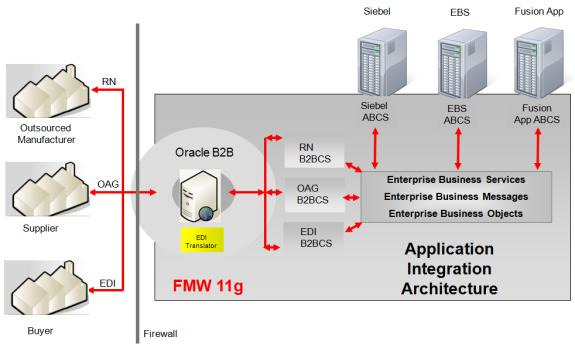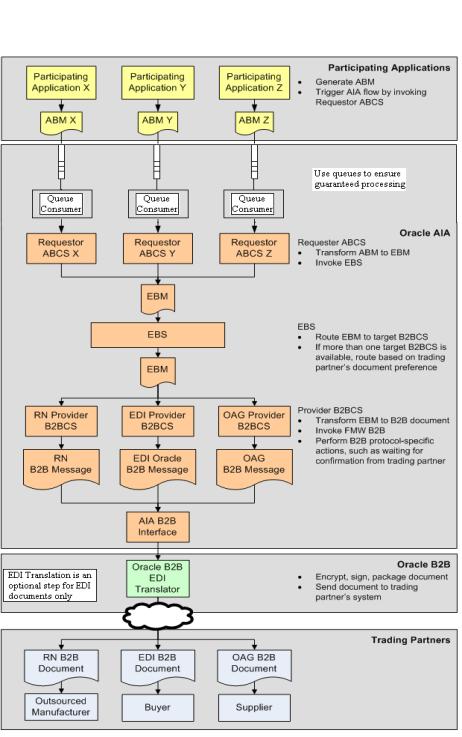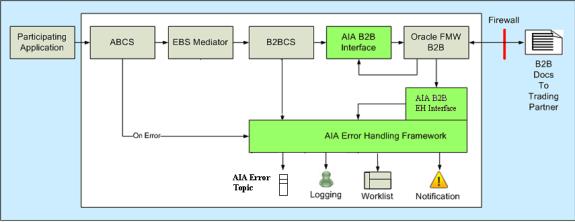16 Introduction to B2B Integration Using AIA
Business-to-business (B2B) integration requires the ability to exchange business information with trading partners using a choice of B2B document protocols.
This chapter includes the following sections:
-
Section 16.3, "Understanding the Oracle B2B Component of Oracle Fusion Middleware"
-
Section 16.4, "Understanding the Foundation Pack Infrastructure for B2B"
16.1 Overview of B2B Integration Using AIA
The Oracle Application Integration Architecture (AIA) B2B solution consists of the following key features:
-
A flexible integration architecture that can be used to rapidly build support for new B2B document protocols.
-
Infrastructure components that can be used to build end-to-end B2B flows using AIA and Oracle Fusion Middleware.
-
Prebuilt support for popular B2B document protocols.
-
Support for customization of shipped B2B integration artifacts.
Figure 16-1 illustrates how the canonical-based integration architecture of AIA can be applied to meet the B2B integration needs of large enterprises.
Following are some of the key benefits of using AIA for B2B integrations:
-
AIA decouples participating applications from the B2B integration layer.
Participating applications no longer need to track the varying B2B integration needs of trading partners. In addition, customers can add support for new B2B protocols and trading partner requirements without any impact to participating application code.
-
B2B document flows are often a subset of tasks that make up complex business processes, such as Order Capture.
By building B2B functionality as a layer on top of Foundation Pack, the functionality is made available for reuse by multiple applications and business processes.
-
Existing AIA Enterprise Business Objects (EBOs) such as Customer, Supplier, Item, Purchase Order, Shipment, Invoice, and Catalog Address map to most of the commonly used B2B documents.
Usage of these readily available EBOs, along with prebuilt B2B connector services (B2BCSs) for these EBOs, result in significant time and cost savings for B2B integrations.
16.2 Understanding B2B Document Flows
This section includes the following topics:
-
Section 16.2.1, "Describing Outbound B2B Document Flows Built Using AIA"
-
Section 16.2.2, "Describing Inbound B2B Document Flows Built Using AIA"
16.2.1 Describing Outbound B2B Document Flows Built Using AIA
Figure 16-2 illustrates a sample outbound B2B flow implemented using AIA:
Following are the key steps in an outbound B2B document flow:
-
Participating applications trigger requester Application Business Connector Services (ABCS) with Application Business Messages (ABMs) as their payloads.
A best-practice recommendation is to use queue-based communication between the application and the requester ABCS while modeling fire-and-forget flows. This ensures that request messages are persisted, thereby guaranteeing their processing.
-
Requester ABCSs transform ABMs into Enterprise Business Messages (EBMs) and then invoke the Enterprise Business Service (EBS) implementation.
-
The EBS introspects the EBM and routes it to the correct provider B2BCS based on the trading partner's B2B document preference.
-
Provider B2BCSs transform the EBM into an industry-standard B2B format and invoke the AIA B2B interface service.
-
The AIA B2B interface service populates the required header parameters and invokes the Oracle Fusion Middleware B2B component, passing the B2B payload as input.
-
Oracle B2B looks up the trading partner agreement corresponding to the trading partners and document type and securely transports the B2B document to the remote trading partner
-
In the case of non-XML format-based protocols such as Electronic Data Interchange (EDI), the translation feature in Oracle B2B can be used to transform the intermediate XML generated by AIA layer to the non-XML B2B document format.
16.2.2 Describing Inbound B2B Document Flows Built Using AIA
Figure 16-3 illustrates a sample inbound B2B flow implemented using AIA:
Following are the key steps in an inbound B2B document flow:
-
Oracle B2B receives B2B documents from trading partners and identifies the sending trading partner and B2B document type.
-
In case of EDI other non-XML formats, Oracle B2B translates the inbound payload into an intermediate XML format.
-
The message is queued into a JMS B2B inbound queue. Along with the B2B document payload, the following key metadata about the B2B document are also passed along to the AIA and SOA composite layer:
-
From Trading Partner
-
To Trading Partner
-
Document Type
-
Document Type Revision
-
-
The AIA B2B interface receives the B2B document and header information from Oracle B2B and routes it to the correct requester B2BCS based on the Document Type parameter.
-
The requester B2BCS transforms the B2B document to the EBM and invokes the EBS.
-
The EBS introspects the EBM and routes it to the correct provider ABCSs.
-
The provider ABCSs transform the EBM to ABM formats and invoke participating application APIs or web services.
16.3 Understanding the Oracle B2B Component of Oracle Fusion Middleware
Oracle B2B is an e-commerce gateway that enables the secure and reliable exchange of business documents between an enterprise and its trading partners. Oracle B2B supports B2B document standards, security, transports, messaging services, and trading partner management. The Oracle SOA Suite platform, of which Oracle B2B is a binding component, enables the implementation of e-commerce business processes.
This section includes the following topic: Section 16.3.1, "How AIA Complements Oracle Fusion Middleware Oracle B2B."
16.3.1 How AIA Complements Oracle Fusion Middleware Oracle B2B
As described in the previous section, AIA leverages the capabilities of the Oracle B2B component to build end-to-end B2B integration solutions. Note especially the key distinctions between the capabilities of Oracle B2B and AIA in the area of B2B integration.
At a high level, Oracle B2B provides B2B support by contributing the following functionality:
-
Transport of B2B document payloads to remote trading partner systems.
-
Support of secure integrations via encryption, digital signatures, and nonrepudiation.
-
Support of industry-standard message-packaging protocols, such as Applicability Statement 2 (AS2) and RosettaNet Implementation Framework (RNIF).
-
Transparent, configuration-based translation between non-XML formats, such as EDI and positional or delimiter-separated flat files, and XML.
-
Support of a single, enterprise B2B information gateway, including auditing and reporting.
At a high level, AIA provides B2B support by contributing the following functionality:
-
Prebuilt transformation between AIA canonical objects and B2B standard document formats.
-
Canonical enterprise object library and services, reference architecture, infrastructure, and developer tools that can be used to build custom B2B integrations.
-
Business process orchestration of B2B flows using SOA integration best practices.
For more information about Oracle B2B, see Oracle Fusion Middleware User's Guide for Oracle B2B.
16.4 Understanding the Foundation Pack Infrastructure for B2B
This section includes the following topics:
Along with the architecture and programming model, additional infrastructure components are delivered with Foundation Pack in support of B2B integrations.
This section provides a high-level description of the B2B infrastructure delivered with Foundation Pack. Chapter 17, "Developing and Implementing Outbound B2B Integration Flows" and Chapter 18, "Developing and Implementing Inbound B2B Integration Flows" provide more details on how to use the infrastructure components shown in Figure 16-4 when you develop and implement B2B flows using AIA.
16.4.1 B2B Support in AIA Error Handling Framework
The AIA Error Handling Framework includes support for error scenarios in B2B integration flows.
-
The AIA B2B Error Handling Interface composite listens for errors that occur in the Oracle Fusion Middleware B2B component.
-
Errors that occur in Oracle B2B are dequeued from the B2B queues and transformed into the canonical AIA fault structure.
-
The AIA Error Handling Framework is then triggered with this fault message as input.
-
Once the AIA Error Handling Framework has been triggered, its delivered error-handling capabilities can be leveraged for error resolution.
Some of the key capabilities of the AIA Error Handling Framework include:
-
Transformation of all errors to a canonical fault message and queuing of the error to the AIA Error Topic.
-
Logging of error information.
-
Option to use the Oracle BPM Worklist application to track error resolution tasks.
-
Option to issue error notifications to preconfigured roles.
-
Ability to launch custom error handling and compensation processes.
These ready-to-use error-handling capabilities reduce the need to duplicate error-handling code across integration code.
For more information about the functionality and uptake of the Error Handling Framework, see "Setting Up Error Handling" in Oracle Fusion Middleware Infrastructure Components and Utilities User's Guide for Oracle Application Integration Architecture Foundation Pack.
16.4.2 AIA B2B Interface
The AIA B2B interface is a reusable mediator-based SOA composite that acts as an abstraction layer between B2BCSs and the Oracle B2B component in Oracle Fusion Middleware. The AIA B2B interface shields B2BCSs from the choice of internal delivery channel employed to connect to Oracle B2B.
Upon installation, the Oracle AIA Installer configures the AIA B2B interface to connect to Oracle B2B using JMS-based queues. However, based on specific integration needs, an implementation may require the use of any of the other available internal delivery channels, such as Oracle Advanced Queuing, File Delivery Channel, and B2B adapter to integrate AIA with Oracle B2B. The AIA B2B interface composite can be modified to replace the use of JMS with any of these internal delivery channels without having to modify every B2BCS.
For more information about the B2B adaptor, see "Getting Started with Oracle B2B" in Oracle Fusion Middleware User's Guide for Oracle B2B.



